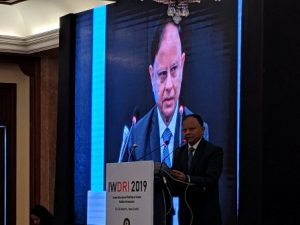Resilient Infrastructure key to achieve SDGs
The Second International Workshop on Disaster Resilient Infrastructure (IWDRI) which featured experts from 33 countries representing a wide variety of development and disaster risk contexts reiterated the importance of disaster resilient infrastructure (DRI) in achieving Sustainable Development Goals (SDGs).

Reiterating the importance of disaster resilient infrastructure (DRI) in achieving Sustainable Development Goals (SDGs) and especially Goal 9 that recognises DRI as a crucial driver of economic growth and development, the Additional Principal Secretary to the Prime Minister, Dr. P. K. Mishra proposed three mantras for achieving sustainability in DRI – the need to focus on the poor and the vulnerable; to follow an inclusive approach of collaboration with multiple stakeholders and ensure proactive connectedness with other Global Processes in Disaster Risk Reduction (DRR).
“Let us not look at infrastructure assets in isolation but focus on interconnected systems and a multidisciplinary approach. Collaboration is not a luxury, it is imperative,” stated Dr. Mishra.
The two-day International Workshop on Disaster Resilient Infrastructure (IWDRI) featured experts from 33 countries representing a wide variety of development and disaster risk contexts, multilateral development banks, the United Nations, the private sector, academia, policy think tanks and other stakeholders.
Also Read : Rebuilding Kerala: UN PDNA exercise to not count just damage, but rebuild better
“The workshop identified good practices of disaster risk management in key infrastructure sectors such as transport, energy, telecom and water.”
It also discussed emerging technologies and nature-based innovation in the context of climate change and its impact on creation, operation and maintenance of infrastructure. The need and practical issues concerning finance and insurance for infrastructure were also discussed during the workshop.
While the Chairman of the 15th Finance Commission of India, N. K. Singh called for “collective action” on resilient infrastructure so that people-centric solutions are found, Dr. Rajiv Kumar, Vice-Chairman, NITI Aayog said, “As millions of people will continue to move to towns and cities in the near future, urban resilience will be the key for sustainability.”
In his inaugural address, Dr. Kumar went on to add, “It is the states where all the action happens” and urged “working in collaboration with state governments” for better results.
Also Read : Disaster funding to States need to be responsive, says Dr. P.K. Mishra
The workshop also proposed further that the knowledge exchange and capacity development partnership, Coalition for DRI (CDRI) must be enhanced at the global level. Recall that India had announced the creation of a CDRI in January 2018 at the first IWDRI soon after the Asian Ministerial Conference on DRR was held in New Delhi in 2016.
Various international agreements have also reiterated the importance and long-term benefits of investing in resilient infrastructure.
“The Sendai Framework for Disaster Risk Reduction (SFDRR), 2015-2030, which is the first major agreement of the post-2015 development agenda, identifies investing in DRR for resilience and to build back better in reconstruction as priorities for action towards reducing disaster risk.”
The Second IWDRI was organised by the National Disaster Management Authority (NDMA) jointly with United Nations Office for Disaster Risk Reduction (UNISDR) in partnership with the Global Commission on Adaptation, United Nations Development Programme and the World Bank.
